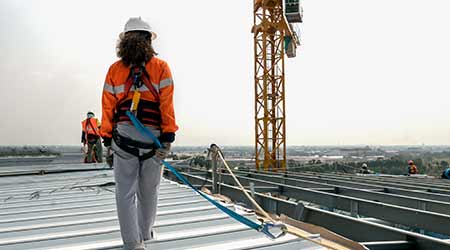« Back to Facilities Management Roofing Category Home
Rooftop Fall Hazards: Preventing Injury, Mitigating Risk
July 25, 2018
- Roofing
By Dan Hannan
Falling when working on a roof, skylight, or hatchway — including from ladders — can result in serious if not fatal injuries. Of the nearly 5,000 workplace fatalities each year, the majority occur as a result of a fall. The Occupational Safety and Health Administration (OSHA) requires employers to protect their employees. Building owners must maintain their buildings (workplaces) in a safe condition to ensure contract and inhouse workers are protected. So, whether you work on, own, or operate a building, you may be exposed to risk and liability from fall hazards.
Consider a roof maintenance task such as a leak repair. Whenever facility owners allow access to these roof environments, fall protection must be provided to prevent injury. A maintenance worker or contractor must be properly trained, outfitted with the right equipment, and preferably authorized to work on roofs. Here are some things to consider when allowing work to be performed on roofs:
• Is the worker or contractor experienced and possesses the right type of training to use safety fall protection equipment?
• Is the roof protected by an engineered fall protection system such as a guardrail, or will the person(s) be using a body harness and lifeline?
• Are skylights, hatchways, or holes present and properly guarded?
• Will access to the roof be controlled, preferably through a work order or permit? This allows authorization, accounting for who’s on the roof, and a review of the scope of work to ensure the necessary safeguards are in place.
• What’s the plan if someone has a medical emergency? If access was by a ladder or stairway, can the injured person be quickly retrieved by the local fire department? Planning would include contacting the fire department to discuss.
• If the roof is ringed by parapet walls, are they at least 39 inches in height? This is the minimum height specified by OSHA to provide a barrier against falling.
Putting a little thought into your rooftop work helps prevent injury and mitigate risk. A more comprehensive rooftop management plan can also be prepared which provides a greater degree of safety assurance.
Dan Hannan is a Certified Safety Professional for Hilmerson Safety Services. For questions or to request a rooftop safety survey feel free to contact Dan Hannan at dan.hannan@hilmersonservices.com.








